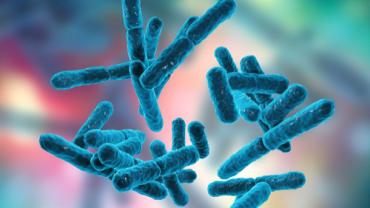
Probiotics are all the rage these days. From things like yogurt, kombucha, and fermented vegetables, which naturally provide beneficial bacteria, to orange juice, chocolate candies, and other things now “fortified” with probiotics, there’s no shortage of convenient ways for people to populate their intestines with good bacteria. But of course, there isn’t just one bacterial strain. There’s a multitude of different organisms that may help digestive function, the immune system, and more. Let’s look more closely at one genus of these beneficial bugs: Bifidobacteria.
The name was coined around 1900 by French pediatrician Henry Tissier. He observed that compared to stools from healthy children, stools from children with diarrhea had a low number of bacteria with a hallmark Y shaped morphology (“bifid”). Bifidobacteria are gram-positive, rod-shaped organisms, and there are at least 45 species and sub-species. The most common strains found in the human gut include B. adolescentis, B. angulatum, B. bifidum, B. breve, B. catenulatum, B. dentium, B. longum, B. pseudocatenulatum, and B. pseudolongum, while the most commonly used form in functional foods and supplements is B. animalis subsp. lactis.
Bifidobacteria populate the intestinal microbiota of mammals and other animals. This genus falls under the phylum Actinobacteria. Other types of bacteria, such as firmicutes and bacteroidetes, predominate in adults, while Actinobacteria are most abundant in breast-fed infants, where bifidobacteria may account for over 90% of the total bacterial population. (In adults, this drops to just 3-6%, and it’s even less in the elderly.) It’s believed that bifidobacteria are among the first colonizing microbes in newborns’ intestines, and that they are instrumental in the maturation of the immune system.
Infants at high risk of atopic disease at 3 weeks and 3 months of age show reduced levels of bifidobacteria in the gut, and these children have a higher incidence of atopic disease by one year of age. Low bifidobacterial levels have also been observed in infants who developed atopy by 2 years of age, or asthma at 4 years of age. According to researchers, “All these data point to a critical role for bifidobacteria in the maturation of our immune system from gestation to childhood, suggesting that the low abundance of these early colonizers is associated with a deviated physiological state in infancy. Indeed, current evidence suggests a role of early life bifidobacteria establishment in programming future health.”
Like other organisms that colonize the large intestine, bifidobacteria must have strategies for overcoming degradation in the stomach and small intestine. These “survival mechanisms” include molecular chaperones and efflux pumps that help protect them and escort them to their destination in the lower GI tract. Once there, anaerobic bifidobacteria feed on non-digestible carbohydrates via fermentation, which results in production of energy/growth substrates (such as acetate and lactate) for other organisms in the gut.
In fact, the ability of bifidobacteria to ferment indigestible carbohydrates is believed to explain their abundance in the infant gut, because human colostrum and breast milk contain human milk oligosaccharides (HMOs) that are otherwise not utilized. After weaning, the total amount of bifidobacteria in the infant gut decreases, and the abundance of different strains shifts: strains of bifidobacteria that best use HMOs decrease, while there’s an increase in strains that are better at metabolizing plant-derived sugars.
This makes total sense: as the diet changes, the gut biome changes. Babies that are no longer consuming breast milk don’t need as much bifidobacteria anymore; what they need are strains better capable of digesting the carbohydrates in, for example, peas, carrots, sweet potatoes, and other plant foods often introduced as some of babies’ first foods.
As for adults, alteration in the number and composition of bifidobacteria in the gut “is one of the most frequent features present” in irritable bowel disorders, colorectal cancer, bronchial asthma, and cystic fibrosis, as well as celiac disease and atopic allergies. Hippocrates wasn’t kidding when he said “all disease begins in the gut.”
However, despite the “buzz” about probiotics and the immune system, it’s currently unknown whether the dysbiosis is a cause of these conditions. It may be an exacerbating factor, or could be an effect resulting from an etiological factor that causes various conditions and alters the microbiota. For now, it’s an association, but the direction of the arrow of causation has yet to be determined:
“It is important to stress that no definitive proof is available on the relationship between reduced bifidobacterial levels, or altered species composition, and disease. However, an aberrant bifidobacterial number or composition is perhaps the most frequently observed intestinal microbiota alteration, being present in many different diseases. This fact suggests an important role for the bifidobacteria population in the intestinal homeostasis.” (Tojo et al., 2014)
Nevertheless, in studies where bifidobacteria strains were administered either alone or in conjunction with other organisms, they’ve been shown to relieve symptoms of IBS, ulcerative colitis, and lactose intolerance, and also to prevent infection in childcare centers. Bifidobacteria may also be helpful for those with allergic rhinitis and certain pollen allergies. Various strains of bifidobacteria have also been shown to reduce inflammatory markers in subjects with metabolic syndrome, cystic fibrosis, chronic fatigue, or psoriasis.
While research remains to be done to clarify which particular species of bifidobacteria are most effective for specific health concerns, overall, the weight of the evidence suggests that there’s a therapeutic role for these organisms in supporting the immune system and helping to combat intestinal dysfunction.
By Amy Berger, MS, CNS